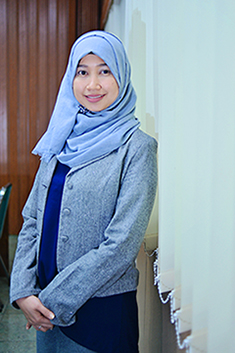Karakteristik dan Stabilitas Fisik Krim Amniotic Membrane Stem Cell Metabolite Product dengan Penambahan SPACE Peptide
Downloads
Pendahuluan: Penggunaan growth factor dalam kosmetika adalah upaya yang menjanjikan dalam mengatasi masalah penuaan, namun juga menjadi sebuah tantangan tersendiri untuk pengaplikasiannya. Karakteristik dan stabilitas fisik merupakan parameter yang penting dalam formulasi sediaan, utamanya pada sediaan kosmetika yang mengandung growth factor karena dapat berpengaruh langsung terhadap efektifitas kandungan zat aktifnya. Tujuan: Mengevaluasi pengaruh perbandingan Amniotic Membran Stem Cell Metabolite Product (AMSC-MP) dan SPACE peptide (F1 = 1:0; F2 = 1:1; F3 = 1:2; F4 = 1:3) terhadap karakteristik dan stabilitas fisik krim antiaging AMSC-MP yang mengandung growth factor. Metode: Uji karakteristik sediaan dievaluasi dengan parameter organoleptis, pH dan daya sebar. Uji stabilitas fisik dilakukan dengan mengevaluasi karakteristik sediaan selama 21 hari penyimpanan. Hasil: Sediaan krim yang mengandung AMSC-MP dengan SPACE peptide memiliki karakteristik; rentang pH 5,8 - 6,5 hasil uji statistik dengan metoda ANOVA satu arah menunjukan perbedaan bermakna, daya sebar sediaan antara 5,6 - 7,2 cm hasil uji dengan metoda Kruskal Wallis menunjukkan tidak ada perbedaan yang bermakna, bau sedikit amis, warna putih susu dan tekstur lembut. Hasil uji stabilitas terhadap nilai pH dan daya sebar menunjukkan bahwa formula krim dengan penambahan berbagai konsentrasi SPACE peptide stabil selama penyimpanan 21 hari. Kesimpulan: Peningkatan konsentrasi SPACE peptide meningkatkan pH sediaaan namun tidak mempengaruhi daya sebar, bau, warna dan tektur sediaan. Semua formula sediaan krim AMSC-MP dengan SPACE peptide stabil selama 21 hari penyimpanan.
Bos, J. D. & Meinardi, M. M. H. M. (2000). The 500 Dalton Rule for the Skin Penetration of Chemical Compounds and Drugs. Experimental Dermatology; 9; 165–169.
Hsu, T. & Mitragotri, S. (2011). Delivery of siRNA and Other Macromolecules Into Skin and Cells Using a Peptide Enhancer. Proceedings of the National Academy of Sciences of the United States of America; 108; 15816–15821.
Kett, V., McMahon, D. & Ward, K. (2004). Freeze-Drying of Protein Pharmaceuticals - the Application of Thermal Analysis. Cryo-Letters; 25; 389–404.
Kumar, S., Zakrewsky, M., Chen, M., Menegatti, S., Muraski, J. A. & Mitragotri, S. (2015). Peptides as Skin Penetration Enhancers: Mechanisms of Action. Journal of Controlled Release; 199; 168–178.
Lambers, H., Piessens, S., Bloem, A., Pronk, H. & Finkel, P. (2006). Natural Skin Surface pH is on Average Below 5, Which is Beneficial for Its Resident Flora. International Journal of Cosmetic Science; 28; 359–370.
Lee, H. J., Kang, S., Lee, E. G. & Sung, J. H. (2014). Efficacy of Microneedling Plus Human Stem Cell Conditioned Medium for Skin Rejuvenation: A Randomized, Controlled, Blinded Split-face Study. Annals of Dermatology; 26; 584–591.
Prakoeswo, C. R. S., Pratiwi, F. D., Herwanto, N., Citrashanty, I., Indramaya, D. M., Murtiastutik, D., Sukanto, H. & Rantam, F. A. (2018). The Effects of Amniotic Membrane Stem Cell-Conditioned Medium on Photoaging. Journal of Dermatological Treatment; 30; 478-482.
Seo, K. Y., Lee, S. E., Hyu, K. D. & Yoon, M. S. (2013). Skin Rejuvenation by Microneedle Fractional Radiofrequency and a Human Stem Cell Conditioned Medium in Asian Skin: A Randomized Controlled Investigator Blinded Split-face Study. Journal of Cosmetic and Laser Therapy; 15; 25–33.
Shin, J. W., Kwon, S. H., Choi, J. Y., Na, J. I., Huh, C. H., Choi, H. R., Park, K. C. (2019). Molecular Mechanisms of Dermal Aging and Antiaging Approaches. International Journal of Molecular Sciences; 20; 2126.
1. The copyright of this journal belongs to the Editorial Board and Journal Manager with the author's knowledge, while the moral right of the publication belong to the author.
2. The formal legal aspect of journal publication accessibility refers to the Creative Commons Attribution-Non-Commercial-Share Alike (CC BY-NC-SA), which implies that the publication can be used for non-commercial purposes in its original form.
3. Every publication (print/electronic) is open access for educational, research, and library purposes. In addition to the objectives mentioned above, the editorial board is not responsible for copyright infringement


.jpg)














